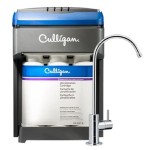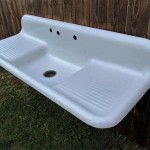Depth of a Kitchen Sink: A Comprehensive Guide
The depth of a kitchen sink plays a crucial role in its functionality and overall user experience. While aesthetics are often a primary concern when choosing a sink, understanding the impact of depth on practicality is equally important. This article explores the various aspects of kitchen sink depth, offering insights into standard measurements, the advantages and disadvantages of different depths, and factors to consider when selecting the ideal sink for a specific kitchen.
Standard Kitchen Sink Depths
Kitchen sink depths typically range from 6 to 10 inches, with 8 inches being the most common standard depth. This measurement refers to the vertical distance from the sink’s rim to the bottom of the basin. While 8 inches offers a good balance between capacity and usability for most homeowners, deeper sinks, ranging from 9 to 10 inches, are gaining popularity. These extra inches can significantly impact the sink’s functionality, particularly for tasks involving large pots and pans.
shallower sinks, around 6 inches deep, are generally found in smaller kitchens or bar areas where space is limited. While they might not be ideal for handling large dishes, their compact size can free up valuable counter space. Ultimately, the optimal sink depth depends on individual needs and the available space within the kitchen layout.
Advantages and Disadvantages of Different Depths
The depth of a kitchen sink offers a range of advantages and disadvantages that should be carefully considered before making a purchase. Deeper sinks, for instance, provide increased capacity, making it easier to wash large pots, pans, and baking sheets. They also tend to splash less, keeping the surrounding countertop area drier. However, deeper sinks can be more challenging for users with shorter stature, potentially causing back strain when reaching down to the bottom of the basin. Additionally, they typically require a higher faucet, which might not fit aesthetically in all kitchen designs.
Standard 8-inch sinks offer a versatile compromise, providing adequate capacity for everyday tasks while remaining relatively accessible. They strike a balance between minimizing back strain and maximizing usability. Shallower sinks, on the other hand, while maximizing counter space, offer limited capacity and can be prone to splashing. They might be suitable for smaller kitchens where washing large dishes isn't a frequent requirement.
Factors to Consider When Choosing a Sink Depth
Several factors influence the ideal kitchen sink depth selection. Existing plumbing configurations are crucial. Changing the depth of a sink often necessitates adjustments to the plumbing, potentially adding to installation costs and complexity. The height of the user is another critical factor. Taller individuals might find deeper sinks more comfortable, while shorter users might prefer a standard or shallower depth to avoid excessive reaching. The frequency and type of cooking and dishwashing tasks also play a role. Households that frequently prepare large meals or use oversized cookware would likely benefit from a deeper sink.
Countertop material and thickness can also impact the sink installation and the available depth options. Certain materials might impose limitations on the sink depth that can be accommodated. Finally, the overall kitchen design aesthetic is a key consideration. The sink should complement the style of the kitchen and integrate seamlessly with the surrounding elements. Considering these factors ensures the chosen sink depth aligns with the specific needs and preferences of the user and the overall kitchen design.
Impact on Functionality and Ergonomics
Sink depth significantly affects both functionality and ergonomics within the kitchen. A deeper sink can improve functionality by allowing easier handling of larger items and reducing splashing. However, it can negatively impact ergonomics if it requires excessive reaching or bending, potentially leading to discomfort and strain. Conversely, a shallower sink might be more ergonomically friendly for some users, but it could compromise functionality by limiting capacity and increasing splashing. Therefore, carefully balancing functionality and ergonomics is crucial when selecting a kitchen sink depth.
The placement of the faucet and other accessories, like soap dispensers, also plays a role in ergonomics. The distance between the faucet and the back of the sink should be considered to ensure adequate space for handwashing and filling containers. The overall layout and design of the sink area should promote efficient workflow and minimize unnecessary movements.
Maintenance and Cleaning Considerations
Maintaining and cleaning kitchen sinks of varying depths present different challenges. Deeper sinks, while offering larger capacity, might require more effort to clean, particularly reaching the bottom of the basin. Shallower sinks, on the other hand, are generally easier to clean due to their accessibility. The material of the sink also influences cleaning requirements. Stainless steel sinks are relatively easy to clean and maintain, while other materials might require specialized cleaning products or techniques.
The shape of the sink basin can also influence cleaning. Sinks with rounded corners are typically easier to clean than those with sharp angles. Additionally, the presence of a garbage disposal can impact the sink's maintenance requirements. Regular cleaning and proper disposal practices are essential for preventing clogs and maintaining optimal hygiene, regardless of the sink's depth.

How To Measure For A Kitchen Sink In 5 Steps Modern Living

Dimension Of Kitchen Sink Standard Sizes In India Best S

A Simple Guide To The Kitchen Sink Size Chica Dragon

How To Choose Your Kitchen Sink Riverbend Home

Nirali Grace Plain Anti Scratch Finish Kitchen Sink Size 485x410 Mm

Prep 30 Stainless Steel Undermount Single Bowl Sink Moen

3 Ways To Measure A Kitchen Sink Wikihow

Prep 23 Stainless Steel Undermount Single Bowl Sink Moen

2 Bowl 0 8mm Stainless Steel Kitchen Sink 7 Inch Depth

Moen 1800 Series Stainless Steel 33 In 4 Hole Double Bowl Drop Kitchen Sink With 7 Depth Gs182154q







